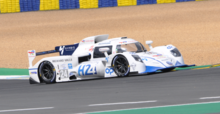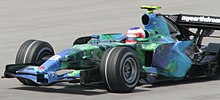Environmentalism in motorsport

The issue of
Initial reception
The first series to respond to the call to make motorsport more environmentally friendly was the International
New championships

Formula E
In 2012, the
Extreme E
Actions taken in other series
Formula One

Formula One's governing body, the FIA, took until May 2007 to act upon the issue of environmental effects the sport was responsible for by holding a discussion in
The car mostly received a cynical reception, Red Bull Racing's Mark Webber observed that "it's good Honda is going green - but there are still 35 private jets parked 20 Kilometres down the road."[7] Briggs commented that "Honda's 'Earth Car' may have attracted cynicism, but the issues it highlights are moving up motorsport's agenda."[6]
In 2013, the FIA made plans to switch from
in 2006.In 2009, the sport introduced kinetic energy recovery. Following a brief ban, these systems were reintroduced in 2011, these technical regulations were further revised for 2014 (see above).
North American motorsport
Sportscar racing
Both the
In the
Since 2011 (Audi and Toyota in 2012, Porsche in 2014, then by Nissan at Le Mans in 2014), the top class of sports car racing, LMP1, has seen hybrid powertrains.
In 2012, Drayson Racing introduced the Lola B12 69/E: a modified a Lola prototype chassis,[9][10][11] and set a world record for electric cars in 2013.[12]
In 2019, ACO has announced Mission H24 to bring hydrogen-powered racing car to 24 Hours of Le Mans in 2024.[13]
The Volkswagen I.D. R has set various records from 2018 to 2020.
Touring car and European open wheel racing
As well as WSR's efforts,
See also
- KERS
- Formula Zero
- FIA Formula E Championship
- TT Zero
- TTXGP
- FIM MotoE
References
- ^ a b c d Motorsport's Green Future, Autosport magazine, Vol. 189, No. 4, Pg. 76, Haymarket Publications. 26 July 2007
- ^ Telegraph Sport (13 September 2014). "Formula E opens with spectacular crash involving Nick Heidfeld and Nicolas Prost as Lucas di Grassi claims win". The Daily Telegraph. Retrieved 13 September 2014.
- ^ "Championship Overview". fiaformula.com. Archived from the original on 9 December 2018. Retrieved 22 April 2019.
- ^ "LEGACY PROJECTS - The Electric Odyssey". Extreme E - The Electric Odyssey. Retrieved 11 March 2022.
- ^ "ST. HELENA". Extreme E - The Electric Odyssey. Retrieved 11 March 2022.
- ^ a b c d Motorsport's Green Future, Autosport magazine, Vol. 189, No. 4, Pg. 79, Haymarket Publications. 26 July 2007
- ^ The Big Questions of 2007, Autosport magazine, Vol. 187, No. 11, Pg. 38, Haymarket Publications. 15 March 2007
- ^ a b Motorsport's Green Future, Autosport magazine, Vol. 189, No. 4, Pg. 77, Haymarket Publications. 26 July 2007
- ^ "Lola-Drayson all electric le Mans prototype". 2 November 2011.
- ^ "Lola-Drayson electric race car employs 'green' composites".
- ^ "Lola-Drayson electric racing car unveiled | the Engineer the Engineer". Archived from the original on 30 November 2018. Retrieved 30 November 2018.
- ^ "Drayson Racing's Lola electric racecar breaks the 333 KPH mark". 18 October 2013.
- ^ Lloyd, Daniel. "ACO, GreenGT Launch 'Mission H24' Hydrogen Strategy". sportscar365.com. Retrieved 9 July 2019.
